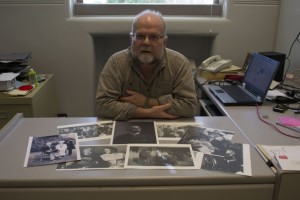Camosun Digital Communications teacher Andrew Bryce is working on a documentary about his great-grandfather Peter Henderson Bryce, who was heavily involved in the welfare of indigenous peoples at the beginning of the 20th century.
“In 2011 my mom passed away and left me a whole box of family genealogy records,” says Bryce. “As I went through them I started seeing references to my great-grandfather, Peter Henderson Bryce, so I started looking him up on the internet and discovered what a character this guy was. What really stood out to me was that he had played a key role in documenting health abuses in residential schools in 1907.”
Bryce says his great-grandfather had a very interesting life and did a lot for Canada’s development, but it was a different time—talking about health abuses in residential schools didn’t necessarily make him a popular guy.

“Early in his career he developed a public health policy for the province of Ontario, and it was copied by the other provinces and a few states in the US,” says Bryce. “He was kind of big man on campus at that time, and he was quoted a lot in newspapers up until about 1907, and then he kind of disappears. You don’t really see too much from him; what happened was his reputation really took a hit because he was contradicting the main narrative of the day. A lot of people didn’t believe him, and he kind of disappeared from the history books.”
When he told people about his great-grandfather’s story, Bryce consistently got the same feedback: that he had to get Peter Henderson Bryce’s story out there. After reconnecting with his extended family and finding out about the many interesting legacies that his family had, he realized there was definitely a story to be told. So, in the fall of 2014, Bryce began to talk with a friend who runs local production company Gumboot Productions about doing a documentary. Gumboot agreed that it was a good idea and began working on it immediately.
Their first big shoot was at a naming ceremony for the Waakebiness-Bryce Institute for Indigenous Health, a public health institute for the study of indigenous issues at the University of Toronto.
Their second shoot took place when it was decided that a historical plaque would be put on Peter Bryce’s grave in Beechwood Cemetery in Ottawa.
“My family and I wrote the historical plaque, and then we had this great big ceremony,” explains Bryce. “We had the head of the Assembly of First Nations, Perry Bellegarde, there. We had a commissioner from the Truth and Reconciliation Commission, Marie Wilson. We had Sheila Fraser, who used to be the federal government’s auditor general, and a lot of historians, as well as my family and a number of survivors from residential schools.”
After gathering some material and getting their story out a bit more, the team was approached about doing a short video for Grade 7 and 8 students, which they agreed to do; that piece will premiere at Royal Oak Middle School on April 1. But the film work doesn’t stop there.
“We still have the larger documentary to do,” says Bryce. “That’s still on the books, and we are planning a shoot for May of this year, and beyond that we need to get some funds. We need a whole whack of funds to finish the film off, and certainly we’re going to try to sell it to broadcasters and get it into festivals and stuff, but our real goal is to get it into libraries and educational institutions.”
